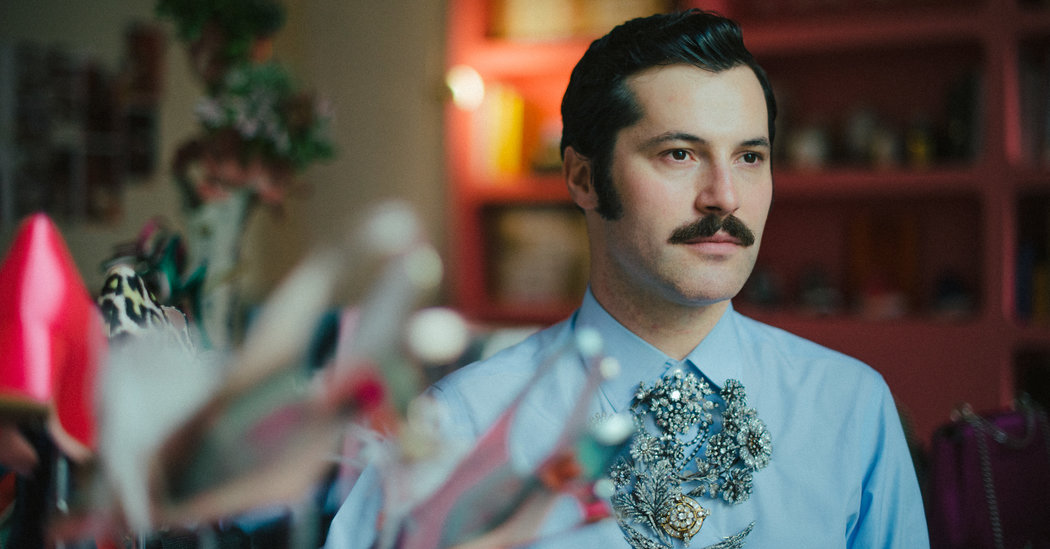
PARIS — Anyone curious about where Roger Vivier, the well-known French shoe brand, may be headed in the hands of its new designer, Gherardo Felloni, might want to check out the creative director’s own flair for accessorizing.
Not necessarily the shoes. Necklaces are his obsession.
Over the past 15 years or so, ever since he landed his first job as an intern at Prada, Mr. Felloni, now 38, has collected so many parures, corsages and cameos — mostly 19th century, none of them faux — that they have their own room in his Paris home.
Some of the major pieces, like an important parure by Castellani, the 19th-century Roman jewelry house, are in a safe deposit box. A couple of pieces are on loan to the Museo del Gioiello, the jewelry museum in Vicenza, Italy. And a separate collection of about two dozen portraits made from shells is still kept at his childhood home in the Arezzo region of Tuscany.
The designer concedes that, in the years since buying his first ring at Gioielleria Pennisi in Milan (on layaway), he’s lost count of the exact number of pieces he owns. He estimates he now has three dozen sets of jewels, give or take. All of them, except the pieces on loan, are part of his current wardrobe rotation.
“The important thing is not just to own them but to wear them,” he said on a recent fall afternoon, gesturing at the woven gold choker set with tiny natural pearls and chains that he had on atop his buttoned-up blue oxford. “They represent me, my style and how I dress. I love them instinctively.
“For me, jewels create confidence,” he continued. “When I wear jewelry, I feel I have the right look. It’s an expression of myself.”
In the pink and white showroom above the Vivier store on Rue du Faubourg St.-Honoré, the designer had laid out an array of favorite pieces, most in their original satin- or velvet-lined boxes.
One set, headlined by a gold foliate brooch studded with many kinds of semiprecious stones, once belonged to a Florentine principessa. On a side table was an imposing parure with amethyst cabochons: a tiara, necklace, brooch, two bracelets and a hair comb. Next to it was an Egyptian revival grouping, and a bracelet with three large lava-stone cameos, a souvenir originally crafted for 19th-century Grand Tour visitors to Pompeii.
Other pieces are of Mr. Felloni’s own design. In one instance, he extracted goose-egg-sized cameos inset in an antique wooden Italian wardrobe and had an artisan in Rome reset them in a pair of gold hoop pendants, adding emeralds to one and rubies to the other. Another time, he combined a pendant with a large natural pearl that once belonged to a Milanese countess with a pair of silver and diamond wings, dating from the Second Empire, into a single brooch.
As for two tremblant corsages in diamonds and time-blackened silver, he might string them on a ribbon, singly or together, and wear it as a necklace for special occasions.
“When I shop for jewels, I am looking for a kind of craftsmanship that you can’t find anymore,” he said. “I feel obliged to buy them because they are unique; they have a history. They were made one by one. I like contemporary things, but I always need to wear a little bit of history.”
In his latest role, Mr. Felloni, who previously worked in the accessories departments at Miu Miu and Dior, has been tasked with reinventing the brand revived by Bruno Frisoni. In February, Mr. Frisoni left the house after 16 years — in which he transformed the Vivier Belle de Jour shoe, a bourgeois favorite ever since Catherine Deneuve wore it in the 1967 Luis Buñuel film of the same name, into its cornerstone.
And therein lies Mr. Felloni’s challenge. Though he believes it was fate that brought him to Vivier.
As it happens, in addition to his jewelry hoard, Mr. Felloni has a small collection of vintage shoes. At an Artcurial auction almost a decade ago, he bought two Vivier styles from the 1950s and ′60s. One is a Belle de Jour style with a round buckle; the other a purple PVC number embroidered with mother-of-pearl. Such finds, he notes, are as rare as the jewels, and why he believes his new job was the work of fate.
“I’ve come to understand that there’s always a link between the things that I like, whether it’s jewelry, art, statues or shoes,” Mr. Felloni said. “Jewels make you feel more powerful. So do shoes. When I sketch shoes I think about confidence. Strange as that may sound, it works.”
Mr. Felloni notes that his inspiration comes in part from the way that Manuela Pavesi, the fashion photographer and stylist who introduced him to Pennisi, wore antique jewels before her death in 2015. “Her house was beautiful, her wardrobe was amazing, and she wore the jewels very naturally; there was nothing too dressy about it,” Mr. Felloni said of Mrs. Pavesi.
Similarly, “I’m trying to look at everything Vivier has done and create something new that people might mistake for something that’s already ours. I’m always saying ‘we need to make a mistake.’”
It was Mrs. Pavesi, he said, who gave him the idea of wearing a white or light blue button-down shirt with diamonds and a Nike jacket.
“I don’t just wear jewels for a dinner party. I wear them even on the Métro,” he said. “It’s an obsession. I spend all my money on jewelry. Finding parures that are intact is very rare. That’s why my bank account is always empty.”







